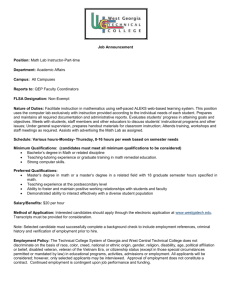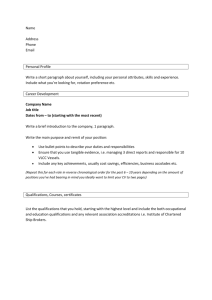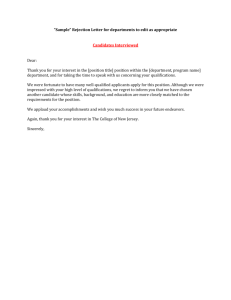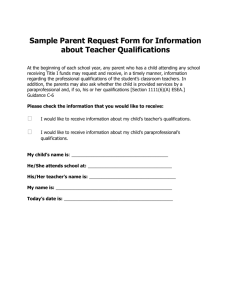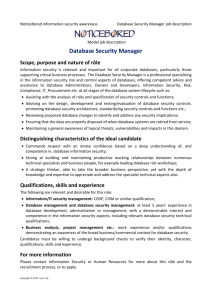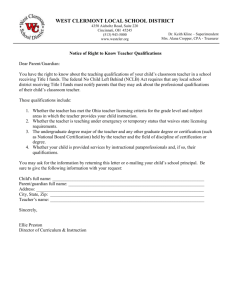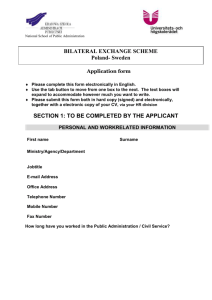Employee Selection Criteria
advertisement
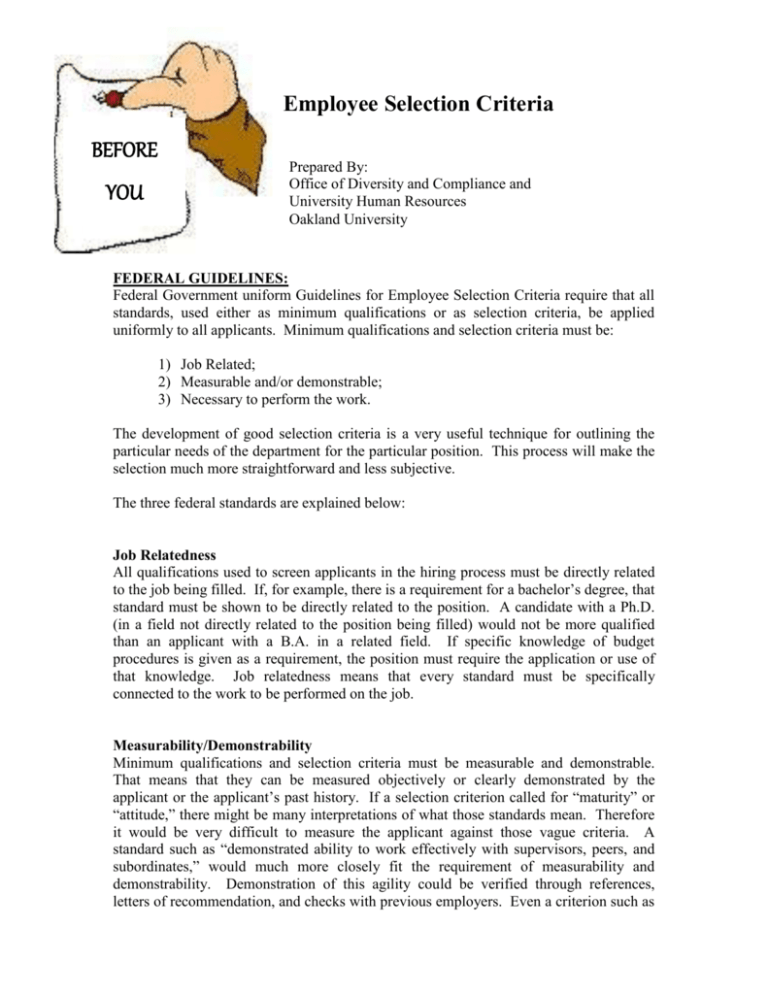
Employee Selection Criteria BEFORE YOU POST Prepared By: Office of Diversity and Compliance and University Human Resources Oakland University FEDERAL GUIDELINES: Federal Government uniform Guidelines for Employee Selection Criteria require that all standards, used either as minimum qualifications or as selection criteria, be applied uniformly to all applicants. Minimum qualifications and selection criteria must be: 1) Job Related; 2) Measurable and/or demonstrable; 3) Necessary to perform the work. The development of good selection criteria is a very useful technique for outlining the particular needs of the department for the particular position. This process will make the selection much more straightforward and less subjective. The three federal standards are explained below: Job Relatedness All qualifications used to screen applicants in the hiring process must be directly related to the job being filled. If, for example, there is a requirement for a bachelor’s degree, that standard must be shown to be directly related to the position. A candidate with a Ph.D. (in a field not directly related to the position being filled) would not be more qualified than an applicant with a B.A. in a related field. If specific knowledge of budget procedures is given as a requirement, the position must require the application or use of that knowledge. Job relatedness means that every standard must be specifically connected to the work to be performed on the job. Measurability/Demonstrability Minimum qualifications and selection criteria must be measurable and demonstrable. That means that they can be measured objectively or clearly demonstrated by the applicant or the applicant’s past history. If a selection criterion called for “maturity” or “attitude,” there might be many interpretations of what those standards mean. Therefore it would be very difficult to measure the applicant against those vague criteria. A standard such as “demonstrated ability to work effectively with supervisors, peers, and subordinates,” would much more closely fit the requirement of measurability and demonstrability. Demonstration of this agility could be verified through references, letters of recommendation, and checks with previous employers. Even a criterion such as “good typist” is not as easily measurable as “ability to type 60 words a minute with only three errors.” The more specific the criterion, the more easily it can usually be measured or demonstrated. Necessary to Perform the Work Successfully All criteria listed as minimum qualifications or selection criteria must be necessary to perform the work successfully. If a bachelor's degree is given as a requirement for the job, but it cannot be demonstrated that the actual degree is necessary for the performance of the job, then a criterion like “bachelor’s degree or equivalent” must be used instead. Relevance and quality of education may be considered in the selection process but must be shown to be necessary for the particular job at hand. When to Use Federal Guidelines Every time a description of qualifications and criteria for a job are developed and recorded on posting notices, advertisements and personnel forms, all three of the federal requirements explained above must be met both for minimum qualifications and for selection criteria. No standard may be used which might have the effect of illegally excluding protected groups either intentionally or unintentionally. In meeting these three requirements, it is essential that a careful and thorough assessment be made of the responsibilities of the position. The assessment should include: a) Understanding the precise responsibilities of the job; b) Defining those responsibilities in measurable or demonstrable terms; c) Determining what education, experience, knowledge, or ability are necessary to perform the work successfully; d) Deciding which qualifications beyond the minimum are important to the particular job; and, e) Establishing the way in which those selection criteria should be demonstrated and measured. Selection criteria are useful in allowing the tailoring of the selection process to any additional necessary qualifications that might not be addressed in a general university classification description. When applicants are compared to each other using selection criteria, the most qualified applicants will be those with the best combination of the standards used. GENERAL PROCEDURES In order to fill an open university position and to find the best-qualified applicant for the position, applicants must be judged by using clearly defined standards or criteria which reflect the specific needs of the department. Two sets of standards are used in screening applicants. These are: 1) Minimum qualifications; 2) Selection criteria. Minimum Qualifications Minimum qualifications are used to screen unqualified applicants by comparing their qualifications to those minimally necessary to do the job. Minimum qualifications for non-instructional positions normally are found in the University Human Resources classification or position description. Selection Criteria Selection criteria are used to determine the best-qualified applicant from among all the candidates who have met the minimum qualifications for the particular position. Selection criteria go beyond minimum qualifications and look at quality and quantity of education, experience, knowledge and other skills that each applicant possesses. Selection criteria also include qualifications that may be unique to the particular job and the particular department rather than the more general minimum qualifications that are used for the university as a whole. When applicants are compared to each other and selection criteria are applied, the best-qualified candidate can be selected. SUMMARY GUIDELINES IN FILLING NONFACULTY POSITIONS 1. The department head must complete the “Personnel Requisition Form.” 2. Job specifications and qualifications are to be developed by the hiring supervisor and the Wage and Salary Office of the University Human Resources. (UHR). 3. Advertisements must be reviewed with UHR to assure consistency with university standards and inclusion of the appropriate “Equal Opportunity Employer” statement. 4. The hiring supervisor and/or a selection committee is responsible for developing written selection criteria for judging the relative merits of the applicants. UHR will assist the hiring supervisor in developing these criteria upon request. 5. When there is a question about whether identified selection criteria are contrary to fair employment or equal opportunity standards, they will be reviewed with the university’s Office of University Diversity and Compliance. 6. The written criteria are to be given to UHR before UHR releases the applications to the hiring supervisor. 7. UHR will screen applications to see that minimal qualifications are met. 8. The hiring supervisor and/or a selection committee must decide which applicants should be interviewed. 9. The hiring supervisor and/or a selection committee must also maintain appropriate records for each interview. 10. The hiring supervisor forwards to UHR the hiring recommendation and rationale based upon the criteria and supported by the interview records. 11. UHR reviews the hiring recommendation and supporting documentation. No employment or salary commitment should be made to any applicant by the hiring supervisor. 12. UHR will notify all applicants of the results of the selection process.
